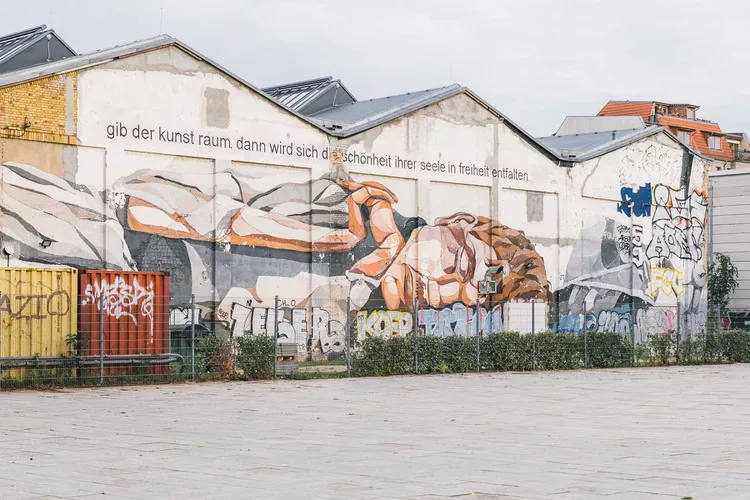Exploring East Berlin’s Transformation into an Artistic Hub
Unused buildings and industrial facilities find new life in the arts.
When I’ve told non-Germans that I live in Berlin, the same question has come up more than once: “West or East?” Although the Wall fell in 1989, in some minds the division still stands. On walks in my neighborhood of Baumschulenweg, I confront a physical reminder of this whenever I cross a double row of cobblestones that marks where the Wall once stood.
Moreover, many popular attractions are located in East German territory, including the Brandenburg Gate, Alexanderplatz, and Museum Island. However, it’s also worthwhile to venture further into the less touristed neighborhoods of East Berlin, where innovative projects and adaptive-reuse initiatives are transforming dormant buildings — many with their own tumultuous history — into community spaces and incubators for the vibrant Berlin art world.

Cultural Projects Revitalizing Old Structures
In Plänterwald, a forest on the banks of the river Spree, I’ve witnessed the emergence of the new Spreepark over the months. Opened in 1969, its predecessor was the only theme park of its kind in East Germany, supposedly attracting around 1.5 million visitors annually. This site, along with its abandoned attractions, is being redeveloped into a large public space complete with rides, arts venues, and a restaurant. Additionally, the transformation of Zenner House, a 200-year-old estate in neighboring Treptower Park, is underway; this space now offers a riverside beer garden and concert venue, with more arts spaces planned.

Urban Renewal in Schöneweide
One day last fall, I crossed the river to Rummelsburg, where a luxury residential complex called the BerlinCampus now occupies what was once Germany’s largest workhouse, opened in 1879, and later an East German prison. Just down the road, I encountered Sisyphos, a popular nightclub in a former dog-food factory where the hedonism runs rampant until Monday morning. Continuing along, I saw Flussbad, a multipurpose arts center, set to open in 2024 in a Weimar-era public-bath complex on the Spree, and Funkhaus, a music venue in the former state broadcasting center.
My journey led me to Schöneweide — an area straddling both banks of the river that deserves a full day of exploration. In the “upper” district, Oberschöneweide, impressive brick factory buildings serve as reminders of East Germany’s historically significant energy industry. The unique architecture and spaciousness have attracted artists, such as Jorinde Voigt and Olafur Eliasson, to establish their private studios in the historic industrial halls.

Art Attractions and Creative Spaces
“All of this has emerged in the last thirty years,” says Solange Lingnau, director of the Reinbeckhallen, once a factory producing high-voltage systems that now houses workshops, event spaces, and a gallery for contemporary art. “The neighborhood has transformed while still keeping a lot of its identity and residents. For them, the development adds value to their own history.” To learn more, there are walking tours hosted by Industriesalon Schöneweide, a museum of industry located in an old transformer factory.
Across a pedestrian bridge to Niederschöneweide, the “lower” district on the Spree’s southern bank, is the Hasselwerder Villa — originally built in 1907 as a residence for Richard and Elsbeth Lehmann, Berliners who were deported and killed by the Nazis. This building, too, has found new life as Novilla, a center for the international creative collective Moving Poets, which hosts events and readings. “It’s maybe a little harder to fall in love with Schöneweide,” says founder and artistic director Till Schmidt-Rimpler. “But once you develop a connection, it’s yours to see.”

From the villa, I began my journey back home, stopping for a cold beer at Revier Südost, a cultural center featuring a beer garden and outdoor market, located within the historic Bärenquell Brewery. The transformations there are just beginning as plans for more commercial spaces unfold within this historic complex. Therefore, it’s evident that these parts of Berlin, while perhaps seemingly harder to navigate, reveal a future that is hidden in plain sight.
A version of this story first appeared in the October 2022 issue of GoTravelDaily under the headline “Renewable Energy.”





